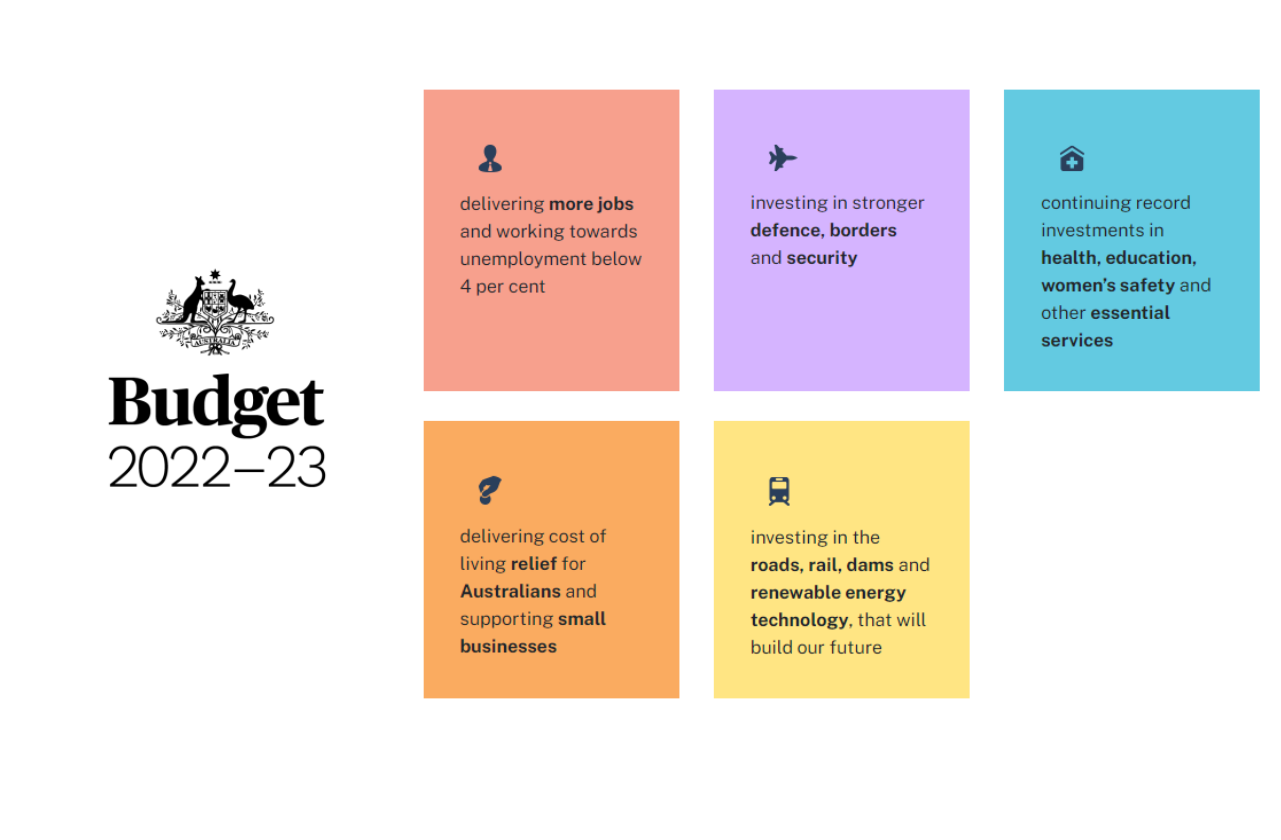2022-23 Federal Budget summary
Treasurer Josh Frydenberg handed down the 2022-23 Federal Budget and as expected in an election year, delivered a big spending Budget with the focus on cost of living support and defence.
We have been busy detailing and summarising what we feel are the key measures announced from a financial planning perspective. For our ongoing service package clients, your adviser will be in contact to provide guidance on changes which impact your strategy.
Superannuation
Extension of the temporary reduction in superannuation minimum drawdown rates
The Government has extended the 50 per cent reduction of the superannuation minimum drawdown requirements for account-based pensions and similar products for a further year to 30 June 2023. The minimum drawdown requirements determine the minimum amount of a pension that a retiree has to draw from their superannuation in order to qualify for tax concessions.
Given ongoing volatility, this change will allow retirees to avoid selling assets to satisfy the minimum drawdown requirements.
Individuals and trusts
Cost of living tax offset
The Government will increase the low and middle income tax offset (LMITO) for the 2021-22 income year. LMITO is targeted at low- and middle-income earners that are most susceptible to cost of living pressures.
The LMITO for the 2021-22 income year will be paid from 1 July 2022 when Australians submit their tax returns for the 2021-22 income year. This proposal will increase the LMITO by $420 for the 2021-22 income year.
Paid parental leave
The Government is investing $346.1 million over five years, from 2021-22 to introduce Enhanced Paid Parental Leave (PPL), which is fairer and provides full flexibility for eligible working families. These changes will increase families’ choice to decide how best to manage work and care. Eligibility for the scheme is also being expanded.
Affordable Housing and Home Ownership
The Government will increase the number of guarantees under the Home Guarantee Scheme to 50,000 per year for 3 years from 2022-23 and then 35,000 a year ongoing to support homebuyers to purchase a home with a lower deposit. The guarantees will be allocated to provide:
- 35,000 guarantees per year ongoing for the First Home Guarantee (formerly the First Home Loan Deposit Scheme)
- 5,000 places per year to 30 June 2025 for the Family Home Guarantee
- 10,000 places per year to 30 June 2025 for a new Regional Home Guarantee that will support eligible citizens and permanent residents who have not owned a home for 5 years to purchase a new home in a regional location with a minimum 5 per cent deposit.
Addressing Cost of Living Pressures – temporary reduction in fuel excise
Global oil prices have risen significantly since the Russian invasion of Ukraine. The Government will help reduce the burden of higher fuel prices at home by halving the excise and excise-equivalent customs duty rate that applies to petrol and diesel for 6 months. The excise and excise-equivalent customs duty rates for all other fuel and petroleum-based products, except aviation fuels, will also be reduced by 50 per cent for 6 months. The Government is responding in a temporary, targeted and responsible way to reduce cost of living pressures experienced by Australian households and small businesses.
The measure will commence from 12.01am on 30 March 2022 and will remain in place for 6 months, ending at 11.59pm on 28 September 2022. Under the measure, existing policy settings for fuel excise and excise-equivalent customs duty, including indexation in August, will continue but on the basis of the halved rates. At the conclusion of the 6 month period the excise and excise-equivalent customs duty rates will then revert to previous rates, including indexation that would have occurred on those rates during the 6 month period.
The rate of excise and excise-equivalent customs duty currently applying to petrol and diesel is 44.2 cents per litre. This measure will halve the rate on petrol and diesel to 22.1 cents per litre from 30 March 2022, with the price faced by consumers expected to be reduced by a larger magnitude given GST will be levied on the lower excise rate.
The Australian Competition and Consumer Commission will monitor the price behaviour of retailers to ensure that the lower excise rate is fully passed on to Australians.
Digitalising trust income reporting and processing
The Government will digitalise trust and beneficiary income reporting and processing by allowing all trust tax return filers the option to lodge income tax returns electronically, increasing pre-filling and automating ATO assurance processes.
The measure will commence from 1 July 2024, subject to advice from software providers about their capacity to deliver.
Business
Small Business – skills and training boost
The Government is introducing a skills and training boost to support small businesses to train and upskill their employees. The boost will apply to eligible expenditures incurred from 7:30pm (AEDT) on 29 March 2022 (Budget night) until 30 June 2024.
Small businesses (with an aggregated annual turnover of less than $50 million) will be able to deduct an additional 20 per cent of expenditure incurred on external training courses provided to their employees. The external training courses will need to be provided to employees in Australia or online and delivered by entities registered in Australia.
Small Business – technology investment boost
The Government is introducing a technology investment boost to support digital adoption by small businesses. The boost will apply to eligible expenditure incurred from 7:30pm (AEDT) on 29 March 2022 (Budget night) until 30 June 2023.
Small businesses (with aggregated annual turnover of less than $50 million) will be able to deduct an additional 20 per cent of the cost incurred on business expenses and depreciating assets that support their digital adoption, such as portable payment devices, cyber security systems or subscriptions to cloud-based services.
An annual cap will apply in each qualifying income year so that expenditure up to $100,000 will be eligible for the boost.
The boost for eligible expenditure incurred by 30 June 2022 will be claimed in tax returns for the following income year. The boost for eligible expenditure incurred between 1 July 2022 and 30 June 2023 will be included in the income year in which the expenditure is incurred.
Social security
Cost of Living Payment
The Government will provide $1.5 billion in 2021-22 to provide a $250 economic support payment to help eligible recipients with higher cost of living pressures. The payment will be made in April 2022 to eligible recipients of the following payments and to concession card holders:
- Age Pension
- Disability Support Pension
- Parenting Payment
- Carer Payment
- Carer Allowance (if not in receipt of a primary income support payment)
- Jobseeker Payment
- Youth Allowance
- Austudy and Abstudy Living Allowance
- Double Orphan Pension
- Special Benefit
- Farm Household Allowance
- Pensioner Concession Card (PCC) holders
- Commonwealth Seniors Health Card holders
- eligible Veterans’ Affairs payment recipients and Veteran Gold Card holders.
The payments are exempt from taxation and will not count as income support for the purposes of any income support payment. A person can only receive one economic support payment, even if they are eligible under 2 or more of the categories outlined above. The payment will only be available to Australian residents.
How can we help?
If you have any questions or would like further clarification in regards to any of the above measures outlined in the 2022-23 Federal Budget, please feel free to book a chat with your adviser.
Until next time.
—Pete
Pete is the Co-Founder, Principal Adviser and oversees the investment committee for Pekada. He has over 18 years of experience as a financial planner. Based in Melbourne, Pete is on a mission to help everyday Australians achieve financial independence and the lifestyle they dream of. Pete has been featured in Australian Financial Review, Money Magazine, Super Guide, Domain, American Express and Nest Egg. His qualifications include a Masters of Commerce (Financial Planning), SMSF Association SMSF Specialist Advisor™ (SSA) and Certified Investment Management Analyst® (CIMA®).


